Aldes ZRT-ZRT-S Zone Register Terminal User manual
- Type
- User manual

READ AND SAVE THESE INSTRUCTIONS
ZRT
®
/ ZRT-S
®
AIRFLOW & ZONE CONTROL
ZONE REGISTER TERMINAL
Description
ALDES patented* Zone Register Terminals (ZRT®) are
designed to introduce exibility and dynamic control to
central ventilation systems. Used in both large and small
systems, the ZRT® zonally regulates ventilation where
it is required without the need for individual fans. Each
ZRT® is a combination grille, register box, control damper,
and optional ow regulator(s). This unique combination
provides up to four dierent control schemes without the
need for expensive pneumatic, electronic, or DDC control
systems.
The ZRT® can be ordered in a supply or exhaust ventilation
conguration. To ensure the proper operation of the
damper assembly, do not exceed 1.0 in. w.g. of dierential
pressure across the damper door. ZRT® 6" supply models
require a minimum ow constant airow regulator.
By replacing static grilles in large central systems, the ZRT-1
model provides on-o control for on-demand ventilation.
This allows central fan downsizing and promotes energy
savings by minimizing necessary fan horsepower and
ventilation-induced heat and cooling loads on the building.
The optional constant airow regulator can be installed in
the ZRT-1’s extended duct collar to place a maximum ow
limit on each terminal. The automatic operation of the
constant airow regulator will prevent noise and excessive
energy consumption caused by over-ventilation, as well as
uctuations in airow rates as total system pressure varies.
The ZRT-2 model can be used for combination low-ow
indoor air quality ventilation and on-demand high-ow
spot ventilation using the same central fan system. This
is achieved by integrating a minimum constant airow
regulator directly into the damper sub-assembly. With the
damper completely closed, the constant airlfow regulator
will allow steady, low-continuous ventilation during fan
operation. When other terminals are opened for on-demand
control of spot ventilation, the closed ZRT-2 will maintain
the specied low-continuous rate through the constant
airow regulator minimum ow control. By opening the
ZRT-2’s control damper, the low-ow regulator is removed
from the air stream, allowing either controlled (using
optional second constant airow regulator) or unrestricted
maximum-boost ventilation.
IOM
ZRT-1 MODEL ZRT-2 MODEL
*U.S. Pat. No. 7,766,734
Airow rate can be set or adjusted by rotating the dial from either
side. The airow indicator will move to show the selected CFM.
The airow label has multiple dened setpoints, but the unique
adjustment mechanism of the CAR3 allows for innite adjustability
between the minimum and maximum limits.
The ZRT® can activate fans used in smaller central ventilation
systems. Through the use of an integral damper end-switch, the
ZRT® can trigger the remote fan to start. This provides the distinct
advantage of allowing the fan to only ventilate specic spaces
when called upon, without the need for separate fans in each
space. This is especially important in residential bath applications
using popular in-line and multi-port fans, where low noise and a
single exterior vent penetration are desired.
Damper
Assembly
Grille (Included)
Integral CAR3 Minimum
Flow Regulator and Damper
16” o.c.
Mounting
Brackets
(Included)
CAR3
Maximum
Flow Regulator
(Optional)
(Not Shown)
CAR3
Maximum
Flow Regulator
(Optional)
Damper
Motor
Cover
24 VAC OR 120 VAC

Page 2 | ZRT / ZRT-S (24 or 120 VAC) IOM
FIGURE 1 - MOUNTING
MAINTENANCE SERVICE PARTS Models Jan.
2014 or Later
Models Dec.
2013 or Earlier
Damper Motor 24 VAC 85 695 85 690
Damper Motor 120 VAC 85 696 85 691
Damper Assembly 24 VAC for Models w/ 4" Duct Collar 36 134 36 114
Damper Assembly 24 VAC for Models w/ 6" Duct Collar 36 136 36 116
Damper Assembly 120 VAC for Models w/ 4" Duct Collar 36 135 36 115
Damper Assembly 120 VAC for Models w/ 6" Duct Collar 36 137 36 117
Joist attachment
spanner brackets
(Included)
IMPORTANT:
Suspension
brackets must
be securely
anchored to joists.
ZRT®
Warning
TO REDUCE THE RISK OF FIRE, ELECTRIC SHOCK, OR INJURY
TO PERSONS, OBSERVE THE FOLLOWING:
1. Use this unit only in the manner intended by the manufacturer.
If you have any questions, contact the manufacturer.
2. Before servicing or cleaning the unit, switch power o at service
panel and lock service panel to prevent power from being
switched on accidentally. When the service disconnecting
means cannot be locked, securely fasten a prominent warning
device, such as a tag, to the service panel.
3. To reduce the risk of re and electric shock, the integral
damper end switch should only be used to switch ventilation
equipment rated Maximum 10A, 1/2 HP.
4. Sucient air is needed for proper combustion and exhausting
of gases through the flue (chimney) of fuel-burning
equipment to prevent backdrafting. Follow the heating
equipment manufacturer’s guidelines and safety standards,
such as those published by the National Fire Protection
Association (NFPA), and the American Society of Heating,
Refrigerating and Air-Conditioning Engineers (ASHRAE), and
the local code authorities.
5. In addition to the following manufacturer’s instructions, it is
necessary to comply with federal, state, and local government
codes. Your purchase of this ALDES ventilation system
represents an investment in the health and comfort of the
occupants, as well as an investment in the protection of
the building from the damaging eects of excessive indoor
humidity.
6. Installation work and electrical wiring must be done by
qualied person(s) in accordance with all applicable codes
and standards, including re-rated construction.
7. When cutting or drilling into wall or ceiling, do not damage
electrical wiring and hidden utilities.
Caution
1. For general ventilating use only. Do not use to exhaust
hazardous or explosive materials and vapors.
2. Automatically operated device. To reduce the risk of injury,
disconnect from power supply before servicing.
3. ZRT® is acceptable for use over a tub or shower when
installed in a GFCI-protected circuit. If wired directly to the
fan or ZRT®, a single Ground Fault Protector on the 120 VAC
common power supply must be used to protect all devices
on the same circuit.
System Design
Satisfactory performance of a central ventilation system requires:
• Proper integration of all the components, compatible grilles,
and wall/roof caps;
• Proper duct design for friction losses;
• Consideration of acoustic and vibration properties of the fan
and its mounting;
• Acoustic properties of the grilles;
• Consideration of the mode of operation, whether continuous
or automatically controlled by dehumidistat, timer, or
occupancy sensor;
• Installation in a heated or unheated space, with consideration
for the potential of condensation in the ducting or fan housing.
Inspect the carton upon receipt to ensure the terminal has not
been damaged in transit. If damaged, it is the responsibility of
the recipient to le a damage claim with the carrier. ALDES is not
responsible for damage incurred during shipment.
Handle the unit with care to prevent damage to the housing and
other components. Store the unit indoors if possible. If outdoor
storage is required, protection against moisture and dirt is
necessary.
Clean the grille monthly (if so equipped).
Mounting
The ZRT® is available with mounting brackets to accommodate
new or existing construction. Spanner brackets that allow
mounting to joists up to 16" on center are provided and should
be secured using the screws provided (See Figure 1). Install
additional blocking or use a single joist bracket if spacing is
greater than 16" on center.
Wiring
The ZRT® is available with 24 VAC or 120 VAC actuator motors. 120
VAC wiring options are shown in Figures 2-4, and 24 VAC wiring
options using the Zone Terminal Fan Control Center (Model ZTC)
are shown in Figures 5 and 6.

Page 3 | ZRT / ZRT-S (24 or 120 VAC) IOM
Intermittent fan
operation using 120
VAC power supply to
ZRT-1 terminals. SPST
convenience switches,
such as manually
operated switches,
mechanical timers, or
dehumidistats, may
be used to control
each ZRT and fan in
this conguration.
Continuous fan
operation using 120
VAC power supply to
ZRT-2 terminals. The
fan and ZRT terminals
may be wired
independently.
Intermittent fan
operation using 120
VAC power supply
to ZRT-1 terminals.
SPST convenience
switches, such as
push-button timers or
motion sensors, may
be used to control
each ZRT and fan in
this conguration.
FIGURE 2
FIGURE 3
FIGURE 4

Page 4 | ZRT / ZRT-S (24 or 120 VAC) IOM
©2020 American ALDES Ventilation Corporation and ©2020 ALDES Canada. ZRT / ZRT-S_(24 or 120 VAC)_IOM_0720. Aldes reserves the right to modify its products at any time to introduce new technologies.
For more information, contact your Aldes sales advisor, visit aldes-na.com, call 1.800.255.7749, or find us on
Intermittent fan operation
using 24 VAC ZTC Zone
Terminal Control Center
and ZRT-1 terminals. SPST
convenience switches, such
as manually operated,
mechanical timers, or
dehumidistats, may be used
to control each ZRT and fan
in this conguration. The
fan is controlled by the ZTC.
IntCont
-------Input------ -------Output to Fan-------
A
FIGURE 5
Continuous fan operation
using 24 VAC ZTC Zone
Terminal Control Center
and ZRT-2 terminals. SPST
convenience switches, such
as manually operated,
mechanical timers, or
dehumidistats, may be used
to control each ZRT in this
conguration. The fan may
be wired independently or
to the ZTC.
IntCont
-------Input------ -------Output to Fan-------
A
FIGURE 6

www.aldes-na.com
CAR3
Constant Airflow Regulator
Installation Operation Maintenance
EN

2
1. AIRFLOW SETTING
Airow rate can be set or adjusted by rotating the dial from either side. The airow indicator will move
to show the selected CFM. The airow label has multiple dened setpoints, but the unique adjustment
mechanism of the CAR3 allows for innite adjustability between the minimum and maximum limits.
Performance charts found in the specications sheet reect this data, with the available range (shaded)
and marked setpoints (lines). The CAR3 will maintain the airow accurately to within +/- 10% of the
indicated lines below for each marked setpoint. At the higher airow rates, the minimum pressure
required to achieve the selected airow may exceed 0.12 in. w.g.
Each diameter has a unique range for both low- and high-pressure variants. The CAR3-L (low-pressure)
is designed for systems with pressures between 0.12 and 1.2 in. w.g. (30 to 300 Pa), and CAR3-H (high-
pressure) between 0.4 and 2.8 in. w.g. (100 to 700 Pa). Factory calibration of the CAR3 is available on
request. Blue color dial = Low-Pressure / Green color dial = High-Pressure.
ADJUSTMENT DIAL
AIRFLOW INDICATOR
2. DIMENSIONS
Ø B A
Size A Ø B
Low-Pressure (Blue)
0.12-1.2 in. w.g
(30-300 Pa)
High-Pressure (Green)
0.4-2.8 in. w.g
(100-700 Pa)
Airow P/N Airow P/N
4'' (100 mm) 3’’ 4.3’’ 15-85 CAR3L4R4 30-160 CAR3H4R4
5'' (125 mm) 3.8’’ 5.2’’ 35-180 CAR3L5R5 55-260 CAR3H5R5
6'' (150 mm) 4.6” 6.0’’ 45-260 CAR3L6R6 60-370 CAR3H6R6
8’’ (200 mm) 6” 7.6” 70-490 CAR3L8R8 100-660 CAR3H8R8
10’’ (250 mm) 7.4” 9.5” 110-620 CAR3L10R10 170-900 CAR3H10R10

3
3. INSTALLATION
Rigid Duct
or Register
Box
CAR3
Duct Collar
DL ≥ 1.2 D
Flex Duct
Flex Duct
CAR3
Duct Collar
or Grille
D
L ≥ 1.2 D
Duct Collar
The CAR3 should be installed in accordance with all applicable building and mechanical codes. If
installed in a metal duct or duct collar with a exible duct connector (listed to UL 2043), the CAR3 must
be inserted at least 1.2 times the duct diameter from the exible duct and/or duct connector.
Orient the CAR3 according to the airow direction
indicated on the device. Horizontal or vertical mounting
is acceptable.
3
6
0
°
Regulator must be installed in a metallic air duct as pictured above. D represents the regulators
maximum outer diameter.
Minimum
1.2 x D
Minimum
1.2 x D
D

www.aldes-na.com
CAR3 IOM_USA. 0620
©2020 American ALDES Ventilation Corporation and ©2020 ALDES Canada. Reproduction or distribution, in whole or in part, of
this document, in any form or by any means, without the express written consent of American ALDES Ventilation Corporation, is
strictly prohibited. The information contained within this document is subject to change without prior written notice.
Aldes North America
USA 800.255.7749 • CAN 800.262.0916 • www.aldes-na.com
5. TROUBLESHOOTING
PROBLEM CAUSE SOLUTION
AIRFLOW TOO LOW
Insufficient duct pressure. Check fan ratings. Replace fan if too small
Increase fan speed.
Excessive duct air leakage. Seal ducts with mastic or tape.
CAR3 damper
not functioning properly.
Check CFM calibration on CAR3.
Adjust to proper airflow value.
AIRFLOW TOO HIGH
AND/ OR NOISY
OPERATION
CAR3 too close to fan. Add manual damper to reduce pressure
across CAR3 to normal operating range.
Fan at too high a speed. Lower fan speed.
CAR3 damper
not functioning properly.
Check CFM calibration on CAR3.
Adjust to proper airflow value.
4. MAINTENANCE & WARRANTY
• The CAR3 needs no maintenance when used in normal conditions. The addition of antimicrobial and
anti-static additives in the material increases the longevity and reliability of the CAR3. There is no risk
of dust deposit or obstruction because the CAR3 has no airways subject to clogging. If the intended
application includes air heavily loaded with dust or grease, access to the CAR3 should be possible
through the terminal device or with an access panel or door.
• ALDES Ventilation Corporation warrants the CAR3 to be free from manufacturing defects and
guarantees the performance within specied limits for a period of seven (7) years when installed in
normal environmental air systems for general residential and commercial heating, ventilating and air
conditioning. This warranty does not include installation in industrial
applications or caustic, noxious
or otherwise hazardous airhandling equipment. This warranty
is limited to replacement of the product
only and does not extend to consequential claims.
-
 1
1
-
 2
2
-
 3
3
-
 4
4
-
 5
5
-
 6
6
-
 7
7
-
 8
8
Aldes ZRT-ZRT-S Zone Register Terminal User manual
- Type
- User manual
Ask a question and I''ll find the answer in the document
Finding information in a document is now easier with AI
Related papers
-
Aldes ZRT-1 Zone Register Terminal Ventilation System Owner's manual
-
Aldes ZRT-PDIL Instructions Manual
-
Aldes 16 330 User guide
-
Aldes H/E150 Installation, Operation & Maintenance Manual
-
Aldes Ventergy Series Fans In Line Ventilator User guide
-
EXHAUSTO AldesConnect Box Operating instructions
-
Aldes VS6 MAX Instructions Manual
-
Aldes RESIDENTIAL HRV H150-TRG Heat Recovery Ventilator Owner's manual
-
Aldes MPV200/8 Installation, Operation And Maintenance
-
Aldes 19 453 Installation, Operation & Maintenance Manual
Other documents
-
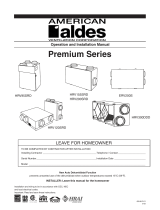 American Aldes Premium HRV300DDD Operation and Installation Manual
American Aldes Premium HRV300DDD Operation and Installation Manual
-
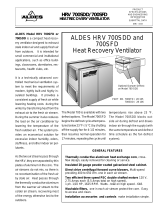 American Aldes HRV 700SDD User manual
American Aldes HRV 700SDD User manual
-
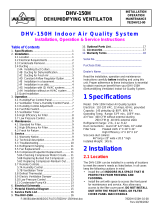 American Aldes DHV-150H User manual
American Aldes DHV-150H User manual
-
American Aldes RDF 12-8IP User manual
-
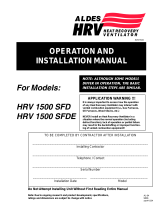 American Aldes HRV 1500 SFD User manual
American Aldes HRV 1500 SFD User manual
-
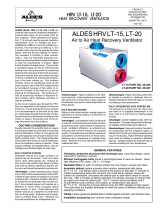 American Aldes LT-15 User manual
American Aldes LT-15 User manual
-
ProLights ECLPANELTWC User manual
-
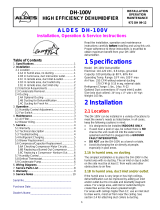 American Aldes DH-100V User manual
American Aldes DH-100V User manual
-
ProLights ECLPANELTWC User manual
-
ProLights ECLPANELTWCJR User manual













